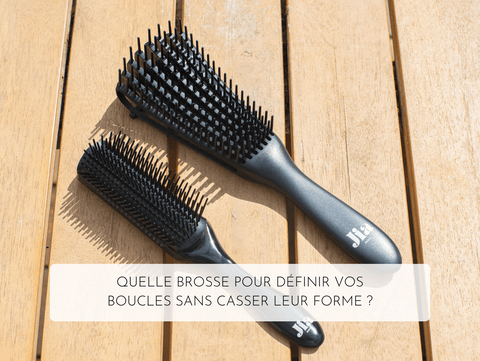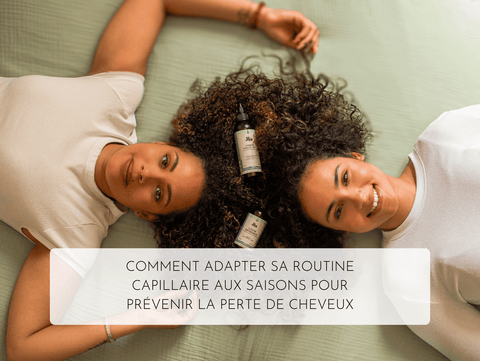You probably know that wavy, curly, frizzy, and kinky hair have specific needs when it comes to hydration and nutrition . But do you really know the difference between the two? 🤔
These two concepts are often confused, which can lead to mistakes in your hair care routine. Indeed, applying care products that are not suited to your needs can have a significant impact on the health of your hair.
In this article, we explain the differences between hydration and nutrition to help you better balance your hair routine!
I. Hydration: what is it?
1. Definition of hydration
The word hydration comes from the Greek "hydro", which means "water" and refers to the absorption of water by a substance, and therefore refers to the process by which an organism, matter or cell absorbs or retains water in order to ensure its balance and proper functioning.
So it's easy to remember that when we moisturize our hair, we're adding water to keep it supple, soft, and elastic. It needs good hydration to prevent dryness, frizz, and breakage!
However, it's important to understand that moisturizing hair isn't just about wetting it with water. To retain moisture in your hair, you need to use products that contain moisturizing ingredients that attract moisture and help seal that water in and keep it inside your hair.
2. Why does textured hair especially need it?
Wavy, curly, frizzy and kinky hair especially needs regular hydration for several reasons:
💧 Porosity: Hair porosity determines its ability to absorb and retain water. Textured hair often has medium to high porosity, which means it absorbs moisture quickly but can also lose it just as quickly. Therefore, it's essential to regularly replenish moisture and seal in moisture with the right products!
🌵 Natural dryness: Unlike straight hair, the sebum produced by the scalp has more difficulty distributing itself throughout the length of textured hair. For this reason, it tends to be naturally drier and requires frequent moisture to stay supple and healthy.
🌀 Spiral structure: The tighter the curl, the more the hair scales tend to be slightly open, which promotes water evaporation.
Additionally, the spiral shape makes hair more fragile and prone to breakage if it isn't well hydrated. Incorporating a moisturizing routine helps maintain its elasticity and strength.
3. Signs of a lack of hydration: dull, dry, difficult to manage hair, excessive frizz
Your hair may be lacking moisture, but you may not even know it. Here are some signs that may indicate a lack of moisture:
🌵 Dry Hair : When your hair lacks moisture and feels rough, brittle, or coarse to the touch.
⚫ Dull Hair : When your hair loses its shine and looks lifeless, lackluster, and tired.
🤯 Unmanageable Hair : When your hair is resistant, difficult to style and detangle, and seems to want to follow its own rules.
➿ Frizz : When the hair scales lift to seek moisture in the air, creating unruly strands that swell and stand on end.
4. Solutions for good hydration
Here's what you need to know to address your lack of hydration.
Look for moisturizers : Moisturizing agents are essential for maintaining moisture in your hair. Here are the main ingredients to look for:
💧 Water : This is the basic element for hydration. Water helps open the hair cuticles so that other moisturizing agents can penetrate and nourish the hair fiber.
🌿 Aloe vera : This plant with nourishing and soothing properties helps attract moisture and lock it into the hair fiber, while calming the scalp.
🍯 Honey : A natural humectant, meaning it attracts moisture from the air to the hair, keeping it hydrated throughout the day. It's also great for adding shine.
🌱 Glycerin : Another humectant that attracts moisture and helps maintain optimal hydration levels, while providing a soft and smooth texture.
🌾 Natural humectants : These are ingredients like propolis or panthenol that work synergistically to capture moisture and keep it inside the hair.
The best techniques for moisturizing your hair:
Here are some effective techniques to properly moisturize your hair:
🔄 LOC Method: The LOC (Liquid, Oil, Cream) method is a three-step routine that will change your hair's life:
-
L for Liquid: Start by applying a liquid product, such as water or a leave-in spray, to provide hydration to the hair fiber.
O for Oil: Next, apply a light oil (like coconut or argan oil) to seal in moisture and prevent moisture loss.
C for Cream: Finally, use a nourishing cream or butter to maintain hair's suppleness and shine while protecting it.
💦 Misting: Misting is the process of spraying water or a moisturizing spray onto your hair throughout the day. This helps rehydrate hair, especially when it's dry or has been exposed to heat.
You can opt for the Jia Paris Moisturizing Spray : Its light and non-greasy formula, enriched with Aloe Vera and Glycerin, quickly penetrates into the heart of the hair fiber, bringing suppleness and shine to the most dehydrated hair.
💧 Use the right styling product:
It's important to use leave-in, leave-in styling products after washing to provide instant, deep, and lasting hydration while nourishing your hair. Choose the right product for your hair type and needs.
In our For My Curls range , we offer three leave-in treatments specially formulated to moisturize your hair. For fine or low porosity hair, the Hair Milk provides light and deep hydration. The Nourishing Smoothie also helps moisturize and lock in moisture. It is perfect for normal hair, providing a balance of nutrition and moisture. Finally, for thick or high porosity hair, the Leave-In Conditioner provides intense hydration and enhanced protection. Each treatment is designed to meet the specific needs of your hair, ensuring optimal hydration. ! 💙
These techniques will help you maintain good hydration levels, which are essential for healthy hair.





Comments (0)
There are no comments for this article. Be the first one to leave a message!